By: Keith Lockwood
Here it comes, Labor Day Weekend, ready or not! This will be a busy weekend for family and friends getting together, for crab feasts, barbecues and fishing at the beach or a favorite fishing hole. There are plenty of recreational crabbing and fishing opportunities out there right now, so be sure to enjoy while the action is hot.
We've all heard the saying that "the early bird gets the worm" and truer words could not better describe the topwater fishing action for striped bass at the outside edges of the Susquehanna Flats. Those that can be on station before sunrise are enjoying some wonderful topwater action for striped bass with a few largemouth bass thrown into the mix now and then. Early risers are also finding shallow topwater action along the shorelines of Turkey Point and Spesutie Island. The Baltimore Harbor area is a good place to look for shallow water action around shoreline structure, old wharf pilings and similar sunken wood. These areas also offer action in the evenings as the sun sets.
White perch and channel catfish are present in many of the same locations that striped bass haunt, and small jigs or spinners on ultra light tackle is a fun way to work shoreline structure. Fishing deeper along channel edges or deep structure such as the Key Bridge piers is a good bet and the shoal and knolls out in the bay are always worth checking. Bloodworms, clams or peeler crabs are all good bait choices of a simple bottom rig.
Striped bass fishing in the upper bay remains good this week but sometimes it takes a little exploring. Love Point and Swan Point remain fairly reliable but other locations reveal that the striped bass are roaming a bit and this might be due to an infusion of bait in the upper bay. Podickory Point, the Triple Buoys and the Dumping Grounds are places to check with a depth finder for fish suspended there. Most boats are live lining spot with good success with a falling tide offering some of the best fishing success. Trolling has been a good option for a mix of striped bass and bluefish. Small Drone spoons, surgical tube lures (red) and bucktails are a good mix in a trolling spread behind inline weights or planers.
The Bay Bridge piers continue to offer good fishing for a mix of striped bass and white perch holding close to structure. Live lining spot to the pier bases has been a productive option as well as jigging and chunking. The white perch are being caught on bait and jigging. It is not hard to tell someone is very happy with this nice striped bass caught near the Bay Bridge Rock Piles.
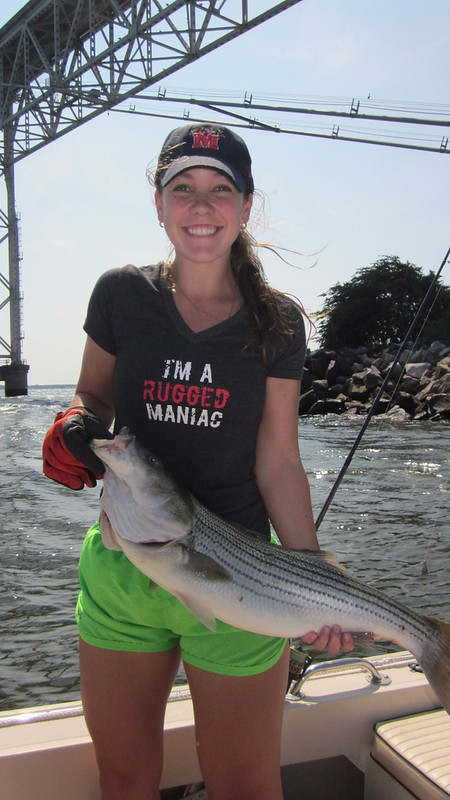
Photo courtesy of Joe Perret
There continues to be plenty of striped bass action in the middle bay region but mostly in the general area of Poplar Island. The Hill, Gum Thickets, Hackett's Bar, Dolly's Lump, Tolly Bar and inside of Eastern Bay are all good places to check for striped bass holding along the deeper edges of these locations. Live lining spot is the number one game in town but trolling and jigging are also good options. There is a lot of bait in the form of bay anchovies in the middle bay region and the presence of bait tends to have the striped bass on the move. Often small striped bass and a mix of Spanish mackerel and bluefish will be chewing up the surface and larger striped bass can be found holding deeper under the surface action. Drone or Clark spoons are being pulled behind planers to catch the Spanish mackerel and bluefish will hit the spoons or red surge tube lures; all are pulled behind planers or inline weights. Dave Zeigler holds up a nice looking Spanish mackerel he caught while trolling near the mouth of the Choptank River recently.
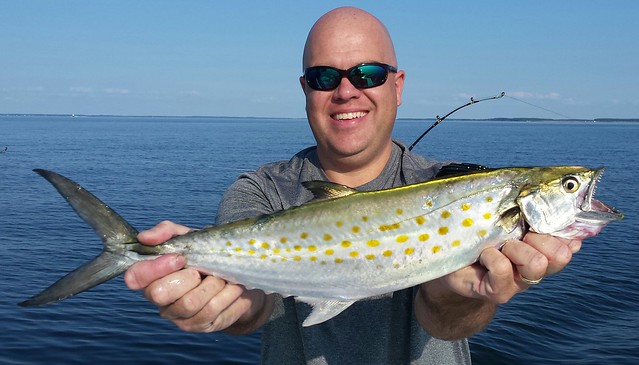
Photo Photo by Rich Watts
The Maryland Artificial Reef Initiative (MARI) and the MD DNR Artificial Reef Program recently completed a productive round of summer construction projects. In mid-May, MARI partner CBF deployed over 150 additional reef balls at the Memorial Stadium reef site located in the upper Bay (Gales Lumps area) between Hart-Miller Is. and Tolchester. The reefballs were constructed by Bill Huppert from MSSA-Perry Hall Chapter and his volunteers, along with Stevenson University. In July, DNR Construction Unit deployed about 70 tons of concrete rubble and blocks at the Tilghman Island fish reef (1.5 nautical miles west of Paw Paw Cove, Tilghman Is.). The material came from a playground demolition project at the Benedictine School and was donated by the school's recycling manager. In July and August , five barge loads of concrete rubble (100-300 tons per load), donated from the Dominion-Cove Pt facility, were deployed at the Taylor's Island fish reef, about 1.5 nautical miles west of Taylor Island. The side-scan image below shows how the rubble was deployed accurately on and around the remains of a sunken barge from an older artificial reef project, over 10 years ago. The barge had rolled over during sinking, exposing a smooth surface which was not acting as well as intended for fish habitat. The rubble enhances the reef and sunken barge by adding more vertical profile, and increasing surface area and complexity (nooks and crannies for small fish to hide).
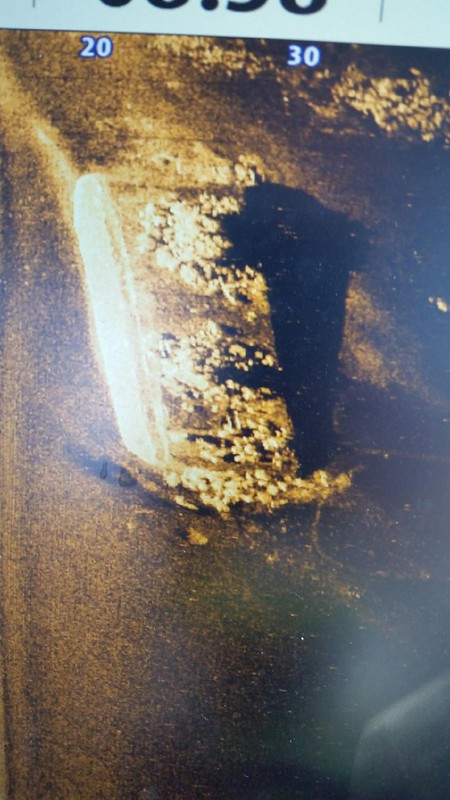
Photo courtesy of Erik Zlokovitz
There has been some good light tackle fishing in the middle bay region this week when breaking fish can be encountered or in the shallower areas during the early morning and late evening hours. Topwater lures are very popular when working the shallows for striped bass near shoreline structure. White perch are also in these same areas and offer a lot of fun on ultra light tackle and small lures. White perch are also being caught while bottom fishing for a mix of croaker and spot in places like Eastern Bay, Dolly's Lump and the region's tidal rivers. The Kent Narrows continues to be a popular place for shore bound anglers to fish for white perch from the bulkheads. Casting small jigs or bottom rigs baited with bloodworms, peeler crabs or clams are good ways to catch them.
The lower bay region has been a hot bed of activity as mixed schools of bluefish and Spanish mackerel chase schools of bay anchovies throughout the region. Some of the best places to find them are where swift currents run along steep channel edges and the bait is pushed along. Casting metal jigs is a fun and popular way to get in on the action and letting your jig fall below the surface action will pay off with a striped bass at times. There are a lot bluefish at the Middle Grounds area and there are also cobia and large red drum in the area. Trolling has been a popular way to catch bluefish and Spanish mackerel with a mixed spread of small Drone or Clark spoons and red surge tube lures behind planers or inline weights. The red drum will strike large spoons if they are in a trolling spread. The cobia are being found near the Target Ship and buoys in the region and can be caught on live bait of by casting large bucktails or swim shads. Dave Andrews was trolling near Point Lookout for Spanish mackerel when he pulled in this strange looking fish that visits Chesapeake Bay during this time of the year; it is called a cutlassfish.
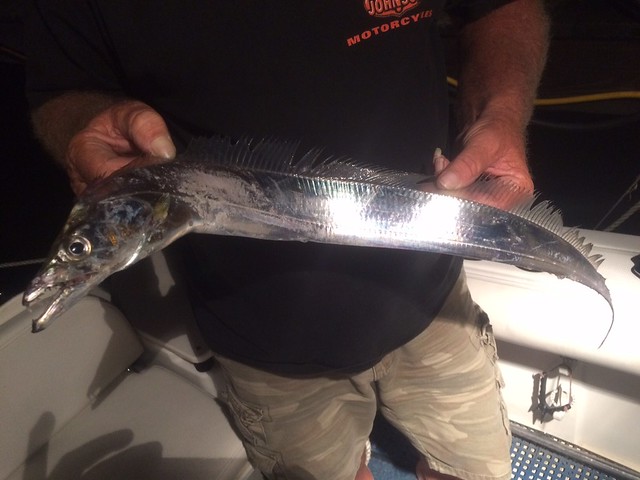
Photo courtesy of Dave Andrews
Shallow water fishing for striped bass has been a good early morning and late evening option at Cedar Point and the mouth of St. Jerome's Creek as well as spots along the eastern side of the bay and the lower Potomac. Topwater lures are perhaps the most popular lure to use.
Bottom fishing for a mix of large spot, medium sized croakers and white perch continues to be one of the best fishing opportunities in the lower bay region this week. The lower Potomac and Patuxent have been offering very good fishing and the Tangier Sound area has also been a good place to fish.
Recreational crabbing continues to get better as the summer rolls on. There are good numbers of crabs to be found in most tidal rivers and crabs have moved far up the rivers into areas they are not often seen due to the lack of rain and increased salinities in the middle and upper river stretches. The largest crabs tend to be deep and smaller crabs and sooks have been shallow for the most part.
Freshwater fishing at Deep Creek Lake continues to be an early morning and evening affair when it comes to fishing for smallmouth bass and largemouth bass. The floating docks have been a good place to target with soft plastics and rocky shorelines have been a good place to cast topwater lures. Largemouth bass are also being found in thick grass in the coves where plastic frogs are a good bet. There are some walleye being caught along the dam face by slow trolling or drifting minnows or worm rigs deep. Surface water temperatures have been around 75° and waters have been slightly stained.
Largemouth bass are always a favorite summer time target for anglers and it often revolves around fishing grass or deep structure. It is hard to find anything more exciting than working a buzzbait or plastic frog over grass and seeing an explosive strike. This is usually an early morning or evening affair but in some situations heavy weedless plastic jigs can be worked down through thick grass later on in the day. Deep structure such as bridge piers, rocks or sunken wood is also a great place to target during the day with crankbaits, slow rolled spinnerbaits or jigs. Largemouth bass fishing in Maryland is not limited to freshwater impoundments; many of the tidal rivers offer good fishing and the Susquehanna Flats large grass beds hold a healthy population of largemouth bass. Sean Allen Sr. holds up a nice largemouth bass he caught in Dundee Creek.
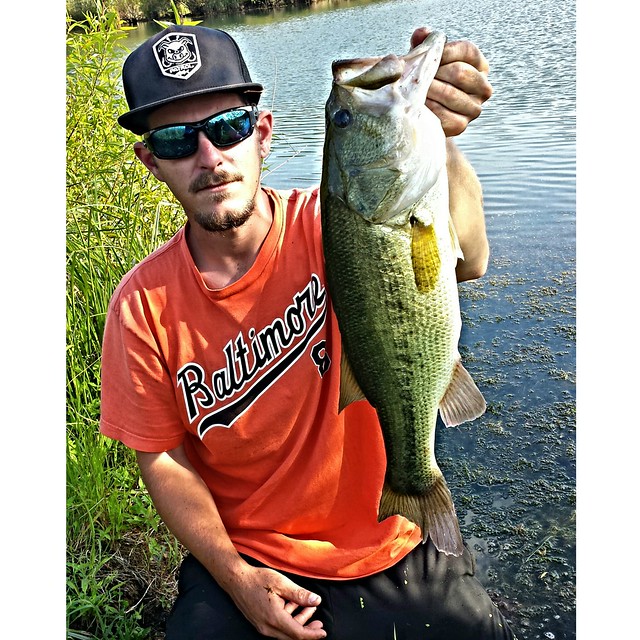
Photo courtesy of Sean Allen Sr.
The inshore coastal waters in the Ocean City area have heated up to 77° in many areas and most fishing is holding steady until cool nights begin to bring water temperatures down. The best time for surf fishing for a summer mix of kingfish, croakers and small bluefish is early in the mornings or in the evenings. Flounder fishing in the inlet and back bay channels has gotten tough as the flounder have spread out in the bay's shallow waters feeding on small fish. Bluefish have been moving through the inlet usually on a flood tide and in the evenings when boat traffic has subsided. There are plenty of croakers in the back bay areas along with small bluefish.
Outside the inlet flounder are being caught on the near shore shoal areas and there are also some big cobia cruising out there as well. Flounder fishing at the wreck and reef sites has been very good. Skylar Hepner is all smiles with this sea bass she caught recently.

Photo courtesy of Skylar Hepner
Out at the 30 Fathom Line skipjack tuna and small dolphin are being caught. At the canyon areas large schools of small dolphin are often being encountered near surface debris with larger "gaffer" sized dolphin being caught while trolling. White marlin releases are increasing as September begins and a mix of yellowfin, bigeye and wahoo are rounding out the mix for the trolling fleet. Deep drop trips are catching some nice golden and blueline tilefish in offshore waters while bait fishing on bottom.
Boom...Morgan
No comments:
Post a Comment